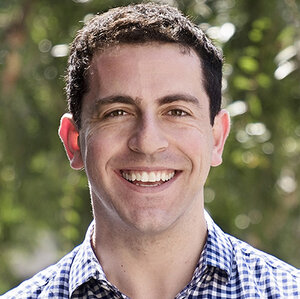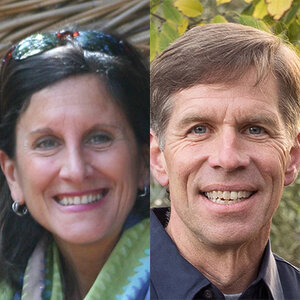Jim Fruchterman, Founder and CEO, Tech Matters: Going for maximum impact, not maximum profit
May 17, 2023
Jim Fruchterman, a self-described “serial tech and social entrepreneur,” is founder and CEO of Silicon Valley-based Tech Matters. The strategic tech nonprofit works globally in collaboration with local partners and donor-investors to launch sustainable tech-for-good social enterprises that leverage cutting-edge technologies made affordable for communities underserved by traditional commerce.
Launched in 2019 under the aegis of Benetech, a software nonprofit he founded in 1989 and where he served as CEO until 2018, Tech Matters has collaborated with tech-focused philanthropies in the United States and local leaders in Africa, Asia, and Latin America to design open-source platforms built for large-scale impact. The first platform, Aselo, modernizes the technology used for children’s mental health helplines; Terraso, launched just last week, is a data-sharing and technology platform to help plan and finance sustainable economies around the world.
A former rocket engineer, Fruchterman received his BS in engineering and MS in applied physics from Caltech (California Institute of Technology) and was named a MacArthur Fellow in 2006.
Philanthropy News Digest spoke with Fruchterman about his latest ventures at Tech Matters, how technology and social entrepreneurship have changed over his career, and his plans to write a book on how to start a nonprofit tech company.
Philanthropy News Digest: Looking back to 1989, when you formed the company that would become Benetech, how would you describe the landscape of Silicon Valley and data technology in particular? What was the insight you had about data and technology and how it could be used in the nonprofit sector?
Jim Fruchterman: Back then, AI was really nascent and really expensive. My first startup raised $25 million to do something that could now be done by a computer science undergraduate in a weekend. Why? Because collecting all the data was expensive and getting all the computers to process all the data was expensive. I wanted to make reading machines for the blind, but in the early 1980s, the cost was prohibitive and could never be justified in the nonprofit sector. And yet, once it was done—once the for-profits had made the investments—then the marginal cost to apply it was quite low.
Today, if you’re an undergraduate, you can take a course in social entrepreneurship. There’s an actual, well-defined, structural path in between traditional charity and traditional for-profit business. And how we use technology is much different. In the 1980s, people were still writing unique software for every single organization—everyone had their own payroll software, for example.
But then people realized they could use another company’s payroll system and adapt their practices to that software. QuickBooks seems obvious now, but a lot of the journey, by being here in Silicon Valley, being on nonprofit boards, having a bunch of friends in my neighborhood who are for-profit entrepreneurs or venture capitalists, got me the education about what works and doesn’t work at scale. It cost them billions of dollars to acquire that knowledge, and I got it on the margin for free.
And that is true in for-profit tech as well—mortgage banking, insurance, restaurants, job training, fill in the blank—we have the opportunity in the nonprofit sector to leverage these verticals for social good in a way that was unimaginable in the 1980s. If I was starting a for-profit company today, I’m going to a tech incubator like Y Combinator; I’m starting with a tech stack that is 98 percent done. Today, we take advantage of everyone else’s hard work; I just work on that top little piece to create my product, my business. And, frankly, with Tech Matters, I’m following the same path, except that I’m going for maximum impact, not maximum profit.
PND: You launched Tech Matters under the aegis of Benetech in 2019, and just last month you re-launched it as an independent nonprofit. First, what’s at the core of Tech Matters’ mission, and second, what’s the value proposition for operating as a nonprofit?
JF: We exist in a capitalist society. I come out of Silicon Valley, and much of the money that funds my work is because people have generated great wealth in for-profit ventures. When we talk about climate change with local leaders in sub-Saharan Africa, we don’t talk about climate. First, let’s ask what they are talking about. They're asking: How do I help local farmers make more money with less water? How do we secure better, higher-paying jobs and better education for kids in my community so that they don’t migrate to the big city or just leave the country? They are worried about health care, their house, having more money in their pocket.
Our goal is to deploy information that helps with all those things and addresses climate change. Capitalism is supposed to have guardrails, and a lot of the problems we run into in the world are when those guardrails are weak, when the rule of law is weak, when a rich person can take away your land with impunity, when an international company can come and poison your land and water with mine tailings or an oil leak.
Capitalism is supposed to have guardrails, and a lot of the problems we run into in the world are when those guardrails are weak, when the rule of law is weak, when a rich person can take away your land with impunity, when an international company can come and poison your land and water with mine tailings or an oil leak.
We built the Aselo program at Tech Matters—our initiative to modernize child helplines around the world—not from the perspective of a VC [venture capitalist] trying to invest in a startup that could sell services to Anthem and United Healthcare or other giants in health care. If you are just looking to make money on mental health for children, you invest in California, because the State of California is spending billions of dollars on kids, and that creates space to experiment on what works and what doesn’t. But when you say it’s for the other 95 percent of people in world that you will never make money off of, the VCs don’t call back.
If you are in the nonprofit space, you find yourself in sub-Saharan Africa where, because of capitalism, there is a generational market failure and the technology that people are using is 15 years old. Remember, it takes billions of dollars to create the latest technology, but it costs relatively little to move a community to technology that is only three to five years out of date. That’s what I’m doing.
PND: You’ve said that technology can be “a way to shift power to people who need better tools to better help themselves and their communities.” At the same time, it takes money and economic power to leverage data and technology, particularly in places where economic power is woven into the fabric of the very problems we’re trying to solve. How does your tech-for-good vision sidestep that hard reality?
JF: Our model really is what I would be doing if I was trying to launch a for-profit startup; it’s just on a different scale. We’re not trying to make billions changing how dentists, restaurants, or big health insurers do business. I’m talking to people who operate modest mental health helplines for kids throughout the world—most of them have a budget of less than $500,000 or $1 million. Salesforce is not going to go out of its way to sell them a product because, frankly, that would be a terrible solution for a nonprofit of that size; it’s too complicated, too expensive, needs too much infrastructure, and there is no money in it.
Our methodology is that of the agile, lean startup; it’s how people build technology today, which is human centered. You talk to your customer, figure out their pain point, alleviate that pain point. We talked to leaders of 25 helplines in the rich world and poorer countries. The one thing they have in common is: Each is using a semi-custom piece of technology built by a local contractor. You’re the only customer for that software, the only one paying for bug fixes and feature enhancements. It’s like payroll software from 25 years ago. Restaurants and golf courses don’t build their own software, so why are child helplines with tiny budgets building their own software? Because there is no market for a for-profit enterprise.
PND: Tech Matters is backed by some big names in tech philanthropy known for their risk tolerance, among them Schmidt Futures and the Patrick J. McGovern Foundation. Why is it important to have risk-tolerant donors, and what does that mean for how you approach the challenges you are trying to address?
JF: It’s about social return. Charities and government agencies are out there spending money to create social goods: fewer hungry kids, better educated kids, better health. If we go to a donor and ask them to invest in tech so those helplines can connect to twice as many kids with the same number of staff, that sounds like a pretty good return on investment. That’s what technology does in business. Why shouldn’t it be doing the same things and in these fields?
A lot about working with our philanthropic partners is trying to find the ones who have the right overlap with your vision. A foundation has a portfolio of projects and a strategy that is board approved, so you need to match what you’re doing with what they’re doing. People in the philanthropic space that came from tech companies tend to be comfortable with the premise of investing in technology for social good.
The sales pitch to early donors is about being social entrepreneurs: “There is nothing here today, but we can all see the big gaping hole in society—the big need. If you invest in us, maybe we’ll help fill that need with a new and exciting social enterprise.” It’s also about relationships, with, for example, McGovern or the Peery family that helped fund Benetech back in the day. It’s organizations like Schmidt Futures that put up the first dollars for Aselo and Terraso to see if these ideas will turn into something real. We started with risk-comfortable donors, then big traditional foundations and international donors like parts of the UN system that are more comfortable in technology. And over the last 20 years, they’ve all gotten more comfortable with tech.
And more and more tech companies are seeing the value-add of collaborating with us in the tech-for-good space. Because they are focused on profit, they’ve already given up on finding markets in sub-Saharan Africa. When I tell them I want to use their technology, 80 percent of the time tech companies give me their older intellectual property for free. Because I’m going for impact and not for profit, I’m doing what their team wishes they could do. They have pride in their technology, what they’ve created, and if I can show them how they can help, for example, disabled kids in sub-Saharan Africa, they’re on board at no real cost.
[M]ore and more tech companies are seeing the value-add of collaborating with us in the tech-for-good space....Because I’m going for impact and not for profit, I’m doing what their team wishes they could do.
PND: What other pain points are there in the tech-for-good space?
JF: We also need to shift minds on prioritizing technology. Technology can’t be seen as an overhead expense. Of course, you want to constrain costs, but you need nonprofit leaders who are comfortable seeing technology as the tool to achieving their goals, not just as a sunk administrative cost.
We also need to figure out a way to make it easy and frictionless to share data. In the for-profit world, I go to a sports website, and 100 companies are tracking my every move. They figured out how to learn from my behavior, they learned how to make money from that—and the website doesn’t crash. But in the nonprofit sector, everything is in silos. No one has figured out how to work with anyone else, and people are paying to collect the same data over and over again.
In the for-profit world, we strip mine you for your data and we make a lot of money. But the social sector doesn’t like the idea of using your data against you. They think that’s unethical. I happen to agree with them. So what do we do? For data, we need something as easy as Creative Commons. For a piece of music, a photograph, or a report, you just slap a Creative Commons license on it, and people know that they can share it worldwide. And everyone understands that they can’t sell it, but they can copy it, share it, use it. Same thing goes with a GPL [general public license] on a piece of software. Every software developer knows what that means. But when it comes to data, people are just boggled.
We need a coalition of the willing to lead the charge for something that’s a lot more lightweight than the current ideas around data trusts. That’s fine if you can afford it, but I work in the market failure parts of the world, and they’re not going to set up a data trust. Instead of having lots of tiny nonprofits, government agencies, and supply chain actors each having a little bit of data about what’s going on in climate change, for example, we could be pooling everyone’s data on the ground and combining it with satellite imagery that gives a real picture with actionable detail in real time. In the United States, we can afford to have models for growing corn in Iowa, but they don’t work in Africa. People need access to the data and access to the tech that lets them build a model that works for their region or their community—that’s the idea behind Terraso.
We need a coalition of the willing to lead the charge for something that’s a lot more lightweight than the current ideas around data trusts.
PND: You’ll be spending part of your summer in Italy with other fellows at Rockefeller Foundation’s Bellagio Center. What’s in store for you and your cohort?
JF: I’ll be with a group of about 15 people for a month, out of 100 2023 fellows from every area of social good and the arts. I’m also part of a dozen fellows who are focused on responsible AI and data, amazing people like Cathy O'Neill and Meredith Broussard, who’ve written deeply on AI and algorithms, Afua Bruce, who is focused on public interest technology, WITNESS executive director Sam Gregory, and world-class journalist Julia Angwin. Besides the work I plan to do on a new book, I’m basically required to just show up for dinner and talk with all these amazing people, spending a month as a group talking and brainstorming. The most exciting thing is that you get to spend a lot of time with people who know a lot more than you do. That adds value to what I’m doing, which is writing a book about leveraging technology for good, and hopefully I can add value to what they’re doing.
And for what I’m working on, there are 1,000 books on how to start a for-profit tech company, so there ought to be at least one on how to start a nonprofit tech company. My book is about how to take those standard business models and tweak them for social good. It’ll look at capital formation—that is, raising nonprofit philanthropic capital—finding talent, leveraging open-source licensing, and so on. The exciting things is, I want 90 percent of the stories to be about other tech-for-good social enterprises, not about the ones that I've started, because this is not an autobiography—it’s a field manual.
One chapter is going to focus on the bad ideas everybody tries in tech-for-good, why they fail 95 percent of the time, and why only 5 percent succeed. Everyone tries to build the app that everyone needs or creates what I call the “one true list” that everyone’s going to go look at, but no one downloads the app, and everyone just uses Google. The exceptions are few and far between. Why? Because, when you go to GuideStar or Wikipedia, you find what you're looking for. For almost all the others, you don’t find it, you never go back, and those projects die. I’m highlighting the apps that didn’t work and the apps that do work, and then trying to explain why.
—Daniel X Matz








Patient funding is crucial for social entrepreneurs to survive the ‘death valley curve’